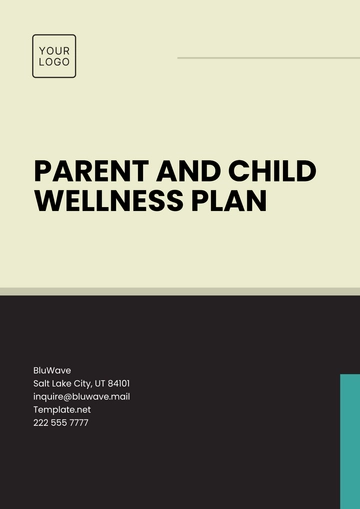Free Wellness Plan

Prepared by: [Your Name]
Company: [Your Company Name]
Date: [Insert Date]
I. Introduction
Wellness is a vital component of a fulfilling and balanced life, encompassing physical, mental, emotional, social, financial, and environmental well-being. This Wellness Plan is designed to provide a structured approach to promoting health and happiness, enabling individuals and communities to thrive.
This Wellness Plan is designed to create a supportive environment that fosters physical, mental, and emotional well-being. By implementing targeted actions and strategies, this plan seeks to enhance the overall quality of life for all participants.
II. Vision and Goals
Vision:
To create a culture of well-being where all individuals feel supported, empowered, and motivated to achieve optimal health.
Goals:
Encourage healthy lifestyle choices.
Provide tools and resources for mental and emotional health.
Cultivate a sense of community and belonging.
Promote sustainable practices for long-term wellness.
III. Key Areas of Focus
A. Physical Wellness
Strategies:
Organize weekly group fitness sessions (e.g., yoga, Zumba, walking clubs).
Offer healthy snacks and meal options in shared spaces or events.
Partner with local gyms or fitness centers for discounted memberships.
Provide ergonomic workstations to prevent physical strain.
Facilitate annual health screenings and flu vaccination drives.
B. Mental Wellness
Strategies:
Implement stress management workshops or webinars.
Create quiet spaces or relaxation zones for meditation and mindfulness.
Offer free or subsidized access to counseling and therapy services.
Promote digital detox initiatives to reduce screen time and improve focus.
Provide educational resources on mental health awareness and stigma reduction.
C. Emotional Wellness
Strategies:
Facilitate regular team-building activities to foster connections.
Encourage the use of journaling or gratitude exercises through group challenges.
Develop peer support networks where members can share experiences and advice.
Celebrate achievements and milestones to promote positivity.
Train leaders to recognize signs of emotional distress and respond appropriately.
D. Social Wellness
Strategies:
Host monthly social events, such as potlucks, game nights, or community service days.
Create interest-based groups (e.g., book clubs, hobby groups, sports teams).
Promote open communication channels for feedback and collaboration.
Support inclusion and diversity initiatives to ensure everyone feels valued.
E. Financial Wellness
Strategies:
Offer workshops on budgeting, saving, and debt management.
Provide resources for retirement planning and financial literacy.
Partner with local financial advisors to offer free consultations.
Create an emergency fund resource guide for members in need.
F. Environmental Wellness
Strategies:
Encourage sustainable practices, such as recycling, composting, and reducing single-use plastics.
Organize community clean-up drives or tree-planting events.
Enhance indoor spaces with plants and natural light to improve mood and productivity.
Support eco-friendly transportation options like biking or carpooling.
IV. Implementation Plan
Roles and Responsibilities:
Wellness Committee: Oversee planning, coordination, and evaluation of initiatives.
Leadership Team: Provide resources and promote a culture of wellness.
Participants: Actively engage in programs and provide feedback.
Timeline:
Phase 1 (Month 1-3): Needs assessment and planning.
Phase 2 (Month 4-6): Launch pilot programs and gather feedback.
Phase 3 (Month 7-12): Expand programs and evaluate progress.
V. Measurement and Evaluation
Key Performance Indicators (KPIs):
Participation rates in wellness programs.
Feedback from surveys or focus groups.
Improvements in physical and mental health metrics (e.g., self-reported well-being, absenteeism).
Increased engagement and satisfaction scores.
Evaluation Methods:
Quarterly surveys to assess program impact.
Annual wellness report summarizing outcomes and areas for improvement.
Regular review of KPIs to ensure alignment with goals.
VI. Sustainability Plan
Secure ongoing funding through partnerships or sponsorships.
Rotate wellness committee members to bring fresh ideas and perspectives.
Develop a digital platform or app to streamline access to resources and events.
Continuously update programs to reflect the evolving needs of participants.
VII. Conclusion
The Wellness Plan serves as a comprehensive framework to promote and sustain the overall well-being of all participants. By addressing key areas such as physical, mental, emotional, social, financial, and environmental wellness, it creates a holistic approach to health and happiness. Through collective efforts, continuous evaluation, and an adaptive mindset, this plan aims to build a supportive and thriving environment.
Together, we can foster a culture of wellness that empowers individuals, strengthens communities, and inspires positive change for the long term.
- 100% Customizable, free editor
- Access 1 Million+ Templates, photo’s & graphics
- Download or share as a template
- Click and replace photos, graphics, text, backgrounds
- Resize, crop, AI write & more
- Access advanced editor
You may also like
- Finance Plan
- Construction Plan
- Sales Plan
- Development Plan
- Career Plan
- Budget Plan
- HR Plan
- Education Plan
- Transition Plan
- Work Plan
- Training Plan
- Communication Plan
- Operation Plan
- Health And Safety Plan
- Strategy Plan
- Professional Development Plan
- Advertising Plan
- Risk Management Plan
- Restaurant Plan
- School Plan
- Nursing Home Patient Care Plan
- Nursing Care Plan
- Plan Event
- Startup Plan
- Social Media Plan
- Staffing Plan
- Annual Plan
- Content Plan
- Payment Plan
- Implementation Plan
- Hotel Plan
- Workout Plan
- Accounting Plan
- Campaign Plan
- Essay Plan
- 30 60 90 Day Plan
- Research Plan
- Recruitment Plan
- 90 Day Plan
- Quarterly Plan
- Emergency Plan
- 5 Year Plan
- Gym Plan
- Personal Plan
- IT and Software Plan
- Treatment Plan
- Real Estate Plan
- Law Firm Plan
- Healthcare Plan
- Improvement Plan
- Media Plan
- 5 Year Business Plan
- Learning Plan
- Marketing Campaign Plan
- Travel Agency Plan
- Cleaning Services Plan
- Interior Design Plan
- Performance Plan
- PR Plan
- Birth Plan
- Life Plan
- SEO Plan
- Disaster Recovery Plan
- Continuity Plan
- Launch Plan
- Legal Plan
- Behavior Plan
- Performance Improvement Plan
- Salon Plan
- Security Plan
- Security Management Plan
- Employee Development Plan
- Quality Plan
- Service Improvement Plan
- Growth Plan
- Incident Response Plan
- Basketball Plan
- Emergency Action Plan
- Product Launch Plan
- Spa Plan
- Employee Training Plan
- Data Analysis Plan
- Employee Action Plan
- Territory Plan
- Audit Plan
- Classroom Plan
- Activity Plan
- Parenting Plan
- Care Plan
- Project Execution Plan
- Exercise Plan
- Internship Plan
- Software Development Plan
- Continuous Improvement Plan
- Leave Plan
- 90 Day Sales Plan
- Advertising Agency Plan
- Employee Transition Plan
- Smart Action Plan
- Workplace Safety Plan
- Behavior Change Plan
- Contingency Plan
- Continuity of Operations Plan
- Health Plan
- Quality Control Plan
- Self Plan
- Sports Development Plan
- Change Management Plan
- Ecommerce Plan
- Personal Financial Plan
- Process Improvement Plan
- 30-60-90 Day Sales Plan
- Crisis Management Plan
- Engagement Plan
- Execution Plan
- Pandemic Plan
- Quality Assurance Plan
- Service Continuity Plan
- Agile Project Plan
- Fundraising Plan
- Job Transition Plan
- Asset Maintenance Plan
- Maintenance Plan
- Software Test Plan
- Staff Training and Development Plan
- 3 Year Plan
- Brand Activation Plan
- Release Plan
- Resource Plan
- Risk Mitigation Plan
- Teacher Plan
- 30 60 90 Day Plan for New Manager
- Food Safety Plan
- Food Truck Plan
- Hiring Plan
- Quality Management Plan
- Wellness Plan
- Behavior Intervention Plan
- Bonus Plan
- Investment Plan
- Maternity Leave Plan
- Pandemic Response Plan
- Succession Planning
- Coaching Plan
- Configuration Management Plan
- Remote Work Plan
- Self Care Plan
- Teaching Plan
- 100-Day Plan
- HACCP Plan
- Student Plan
- Sustainability Plan
- 30 60 90 Day Plan for Interview
- Access Plan
- Site Specific Safety Plan





























